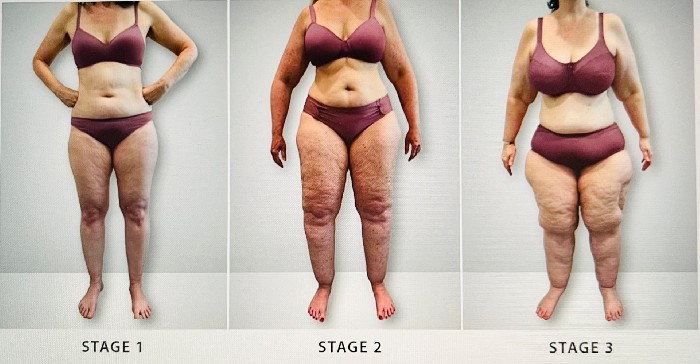Lipedema is one of the most misunderstood and underdiagnosed conditions affecting women worldwide. Despite being incredibly common, many people – including medical professionals – still haven’t heard of it. When I was first searching for answers about my disproportionate lower legs, I kept hitting dead ends. Google wasn’t helpful, and my GP dismissed my concerns as water retention or Lymphedema not Lipedema.
So, is Lipedema common? And why do so few people seem to know about it?
How Many People Have Lipedema?
Estimates vary depending on the country and study, but research suggests that between 11% and 17% of women worldwide may suffer from Lipedema. That’s millions of women globally – and yet Lipedema is often mistaken for simple Obesity or lymphatic issues.
To put it in perspective:
- In the United States alone, it’s estimated that 17 million women may have Lipedema
- In the UK, that number could be over 3.5 million
- Worldwide, a whopping 350 million women could be affected
So Why Is Lipedema So Often Misdiagnosed?
There are several reasons why Lipedema is so widely underdiagnosed:
- Lack of awareness among healthcare providers – many GPs and nurses simply aren’t trained to recognise it
- Symptoms mimic obesity – especially in the latter stages of Lipedema
- Women are often told it’s their fault – that they need to exercise more or lose weight
- Stigma around larger bodies – this leads to missed or delayed medical support
- No single diagnostic test – it’s still a clinical diagnosis, based on symptoms and physical appearance of Lipedema. However, you can use the Lipedema pinch test as a starting point.
All of the above reasons mean that women often go decades without a diagnosis, despite seeing multiple doctors and trying endless diets. It’s incredibly dangerous as the lack of response to diet and exercise causes many women to resort to disordered eating patterns because of Lipedema.
Is Lipedema Getting More Common?
It’s unlikely that Lipedema itself is becoming more common – what’s changing is Lipedema awareness. Social media, like Lipedema Instagram accounts, community blogs (like this one), forums like Reddit and patient-led advocacy groups have helped thousands of women discover the truth about their bodies.
We’re now seeing more:
- Research studies
- Doctor training
- Support groups
- Visible public figures/influencers talking about Lipedema
That’s leading to more diagnoses, but also shining a light on how many cases have been missed over the years. I’ll forever be grateful for these resources in helping me get my own Lipedema diagnosis in 2022.
Why Early Diagnosis Matters
The earlier Lipedema is caught, the better. Without proper treatment using conservative measures for Lipedema, it can:
- Progress to more advanced stages
- Cause chronic Lipedema pain and mobility issues
- Lead to secondary Lymphedema
- Affect mental health, self-esteem, and daily life
Early treatment options include:
- Lipedema compression garments
- Massage for Lipedema
- Lipedema workout strategies like walking or swimming
- Anti-inflammatory diet for Lipedema
- Liposuction, such as WAL Liposuction (in later stages or if conservative treatment fails)
If you’re unsure what you’re dealing with, check out our Find a Lipedema Specialist directory to speak to someone who really understands Lipedema.
How to Know If You Might Have Lipedema
Wondering if your symptoms match? Here are some red flags that might suggest you have Lipedema:
- Your lower body (hips, thighs, knees, calves and ankles) are significantly larger than your upper body
- You have easy Lipedema bruising and your legs feel painful or heavy
- You’ve tried every diet and exercise program – but your leg fat won’t budge
- Swelling that gets worse during the day or in hot weather
- You’ve been told it’s ‘just weight gain’ – but it doesn’t feel right
Still unsure? Head over to our Lipedema Symptoms blog for a full breakdown.
You’re Not Alone – Even If It Feels Like It
One of the hardest parts of having Lipedema is how isolating it can feel – especially when doctors don’t take you seriously or when you don’t have a name for what’s happening to your body.
But here’s the truth:
You are not the only one.
You are not making it up.
And you deserve answers.
We created r/lipedema to give women a place to connect, ask questions, and feel seen. It’s grown quickly and has become a go-to community for support and shared experiences – come join the rest of us lippy ladies if you haven’t already.
So, Is Lipedema Common?
Absolutely – Lipedema is far more common than most people think. It affects millions of women across the world, yet is still rarely diagnosed and is often misunderstood. The good news is: awareness is growing, and support is more available than ever before!
If you’re reading this and wondering if you might have Lipedema – trust your gut. Keep researching. Keep pushing. And know that the community is right here with you.
Disclaimer: My blogs talk about Lipedema, diet, surgery and much more. I’m talking from my point of view to help women, and remind them they are not alone. I am not a medical professional, so the content above is from my own perspective with research I have done into the topic. It’s not meant as medical advice, you should always consult your doctor or a specialist for both your diagnosis, and a treatment plan.
You may also be interested in:

Sophie is the founder of Lipedema and Me and Find a Surgeon. A fellow Lipedema sufferer based in the UK, she’s experienced first-hand the challenges of getting diagnosed and accessing surgery. Today, her mission is to support other women with Lipedema – raising awareness, sharing resources, and helping others feel less alone on their journey.



